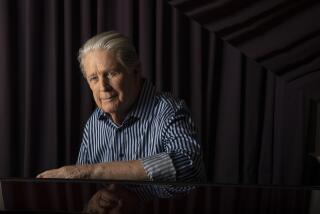Wilson Shows Enigmatic Power
- Share via
Cassandra Wilson is an enigma. An elusive musical mystery. How else to describe a performer who is simultaneously one of the best-selling jazz acts in the world and one of the art’s most indefinable practitioners?
Wilson’s appearance at the Wiltern Theatre on Saturday night was a classic example of her capacity to captivate and distance--to dominate a performing space with the emotional impact of a grande diva while maintaining the demeanor of a shy young woman.
It also was a demonstration of the power of those enigmatic qualities.
Dressed in a floor-length, body-hugging gown, her colorful dreadlocks swarming around her face, Wilson performed her music with a minimum of outgoing theatrics. A turn of the hand, a shift of her hips, a hand raised to her forehead were all she needed to make her points. And the very smallness of her gestures, the sense of intimate connection they suggested, became enough to draw one to her.
The process was light years removed from the far more common performing style that swamps an audience in brassy climaxes. But, because Wilson’s approach, by its very minimalism, insisted that her listeners share the music, her presentation afforded--for those willing to share her creative aura--a rare opportunity to experience the essence of a performer’s art.
The experience was enhanced by Wilson’s selection of songs and the musical settings that surrounded them. Relying mostly on numbers from her hit album, “Blue Light ‘Til Dawn,” and a new recording, “New Moon Daughter,” scheduled for release next month, she ranged from the Monkees’ “Last Train to Clarksville” and Hank Williams’ “I’m So Lonesome I Could Cry” to Robert Johnson’s “Hellhound on My Trail” and U2’s “Love Is Blindness.”
Her six-piece backup ensemble replicated the remarkable textures of the songs’ recorded versions. The arrangements, filled with chattery, disjunct rhythms (some supplied by washtub, hubcaps and bird whistles) played circuitously around the rhythms, generating propulsion and drive via implication and suggestion.
Was it jazz? Perhaps not in the traditional definition, but it was music that could not have been created by someone who did not come from a jazz sensibility. The great strength of jazz has always been its ability to open itself to new ideas. And the one non-enigmatic aspect of Wilson is her desire to take jazz singing into territories yet unexplored.
More to Read
The biggest entertainment stories
Get our big stories about Hollywood, film, television, music, arts, culture and more right in your inbox as soon as they publish.
You may occasionally receive promotional content from the Los Angeles Times.










